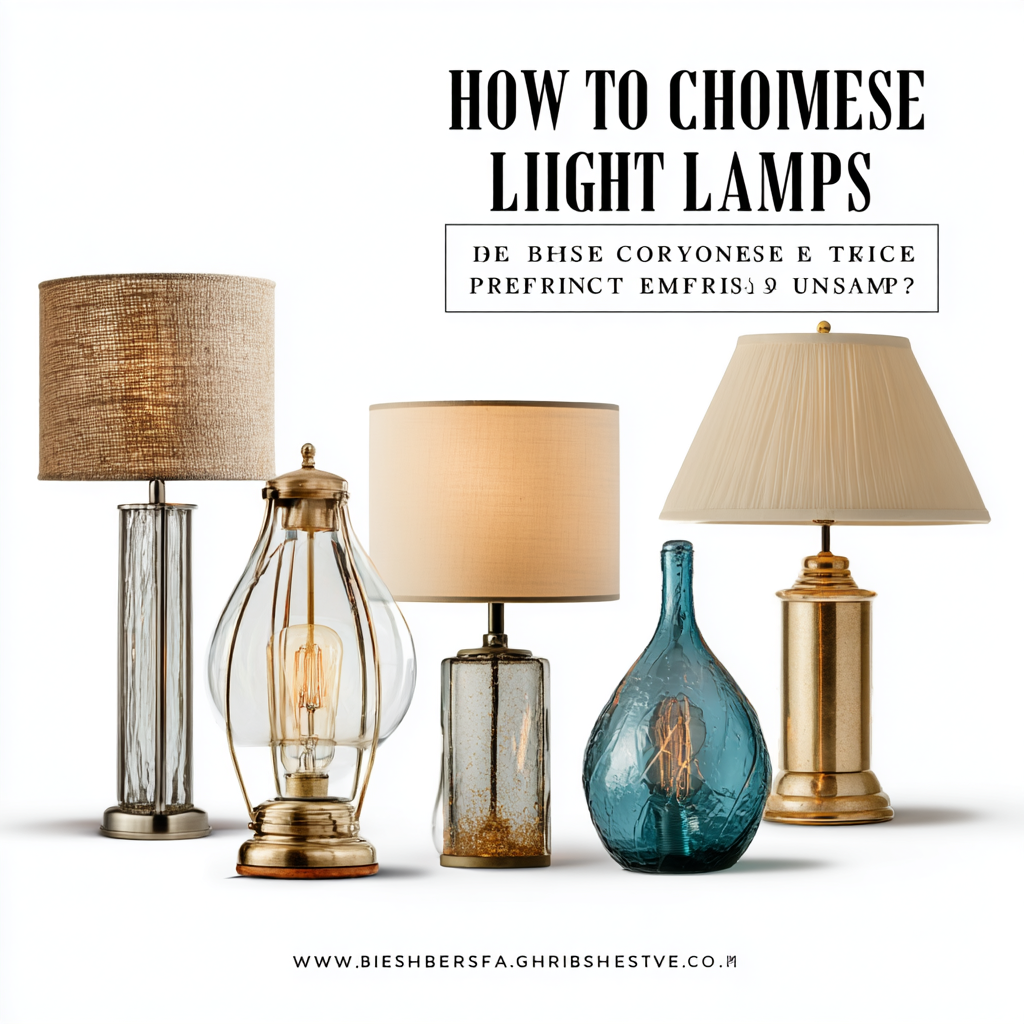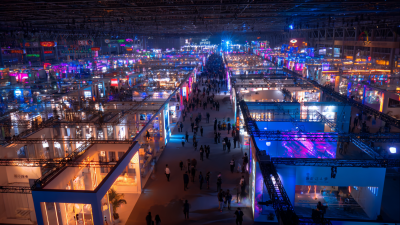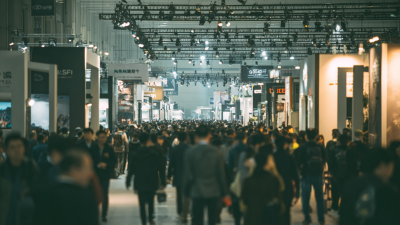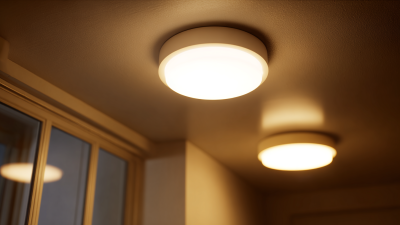In the ever-evolving world of interior design, the significance of choosing the right light lamps for your home cannot be understated. According to a report by the American Lighting Association, the right lighting can enhance the aesthetics of a space, improve mood, and even affect productivity levels. With the global light lamps market projected to reach $78.5 billion by 2027, it's clear that homeowners are investing more than ever in lighting solutions that not only beautify their homes but also cater to their functional needs.

Lighting expert and interior designer, Sarah Johnson, emphasizes the importance of selection: “The right light lamps can transform the ambiance of your home and create a sense of comfort and style.” Given the variety of designs, technologies, and purposes available, choosing the best light lamps requires careful consideration of both practical aspects and personal preferences. This guide aims to provide a comprehensive overview to help you navigate the options and make informed decisions, ensuring that your home is both inviting and functional.
When selecting light lamps for your home, it's essential to consider three critical factors: brightness, color temperature, and energy efficiency.
Brightness, measured in lumens, indicates the amount of light emitted by a lamp. According to the U.S. Department of Energy, a bulb that produces 800 lumens can replace a traditional 60-watt incandescent bulb, providing ample light while significantly reducing energy consumption. This shift not only enhances the home's ambiance but also contributes to lower electricity bills.
Color temperature, indicated in Kelvins (K), plays a vital role in setting the mood of a space. Warm white light (2700K-3000K) creates a cozy atmosphere ideal for bedrooms and living areas, while cool white light (4000K-5000K) is better suited for workspaces, promoting focus and productivity. The choice of color temperature can influence not only aesthetics but also behavioral responses. Research from the Lighting Research Center indicates that warmer lighting can enhance relaxation, while cooler lighting can boost alertness.
Energy efficiency is another key aspect to consider. LED lamps, for instance, use up to 75% less energy than incandescent bulbs and can last up to 25 times longer. The Energy Star program reports that using energy-efficient lighting can save homeowners approximately $225 in energy costs over the lifetime of a single fixture. By prioritizing brightness, color temperature, and energy efficiency, you can create a beautifully lit and sustainable home.
 When selecting the ideal light lamps for your home, it's essential to understand the different types available on the market. LED lamps are known for their energy efficiency and longevity, making them a popular choice for environmentally conscious consumers. They emit bright light and come in various color temperatures, allowing you to create the perfect ambiance for any room. Additionally, LED lamps have a significantly longer lifespan compared to other types, reducing the need for frequent replacements.
When selecting the ideal light lamps for your home, it's essential to understand the different types available on the market. LED lamps are known for their energy efficiency and longevity, making them a popular choice for environmentally conscious consumers. They emit bright light and come in various color temperatures, allowing you to create the perfect ambiance for any room. Additionally, LED lamps have a significantly longer lifespan compared to other types, reducing the need for frequent replacements.
On the other hand, incandescent bulbs offer warm lighting that many find soothing and inviting. Though they consume more energy and have a shorter lifespan than LEDs, their affordable price and consistent performance make them a staple in many households. Fluorescent lamps, with their bright and cool tones, are ideal for workspaces and kitchens. They are efficient and long-lasting but can sometimes produce a harsh light. Lastly, halogen lamps, a type of incandescent bulb, provide a crisp white light and are great for accent lighting, but they can get quite hot and may require more careful placement in your home. Understanding these differences will help you create a well-lit, comfortable living space tailored to your needs.
Lighting plays a pivotal role in shaping the aesthetics and mood of a home. The right light fixture can transform a space from bland to inviting, enhancing its overall ambiance. For example, warm-toned lights can create a cozy atmosphere in living areas, encouraging relaxation and conversation, while cooler tones may be more suitable for workspaces as they promote focus and productivity. When considering the placement and type of lighting, it’s essential to think about how these choices impact the emotional experience of a room.
Moreover, light fixtures are not just functional elements; they serve as design statements that reflect personal style. A stunning chandelier in the dining room can serve as a focal point and elevate the overall decor, while minimalist pendant lights might complement a modern kitchen. Mixing different light sources, such as ambient, task, and accent lighting, can further enhance the visual appeal and functionality of spaces. By thoughtfully evaluating your lighting options, you can significantly influence how each area feels, making your home a more harmonious and inviting place.
When selecting the best light lamps for your home, understanding the latest lighting trends and technologies is essential. One notable trend is the move toward energy-efficient LED lighting. These bulbs not only consume less power but also last significantly longer than traditional incandescent bulbs.
Additionally, advancements in smart lighting technology allow homeowners to control their lighting through mobile apps or voice assistants. This feature offers convenience and the ability to customize ambiance according to different occasions.
Another emerging trend is the incorporation of human-centric lighting designs that prioritize natural light's benefits. By mimicking the spectrum of daylight, these lighting solutions can enhance mood and productivity. Dimmers and color-tunable options are gaining popularity, allowing homeowners to adjust brightness and color temperature to maintain comfort in various settings.
As you explore the best light lamps for your home, consider how these trends and technologies can not only illuminate your space but also contribute to a healthier, more connected living environment.
When selecting lighting solutions for your home, prioritizing eco-friendly options can significantly reduce your carbon footprint while also enhancing your living space. According to a report by the International Energy Agency (IEA), lighting accounts for about 15% of global electricity consumption. This highlights the importance of choosing energy-efficient lighting that not only minimizes environmental impact but also lowers electricity bills. LED bulbs, for instance, consume up to 75% less energy than traditional incandescent lights and have a lifespan that is 25 times longer, making them a sustainable choice for any home.

In addition to energy efficiency, it's vital to consider the materials used in light fixtures. Sustainable brands are increasingly utilizing recycled materials and eco-friendly manufacturing processes. Research by Green Building Advisor indicates that using sustainable materials in home fixtures can contribute to better indoor air quality and overall wellbeing. By opting for products made from reclaimed wood, recycled metals, or non-toxic finishes, homeowners can create a healthier living environment. As the demand for sustainable lighting solutions grows, consumers can expect more innovative products that blend functionality with environmental stewardship.





